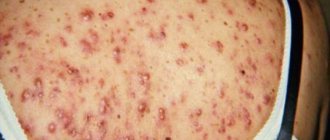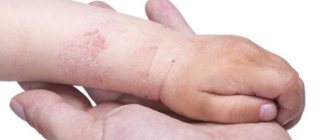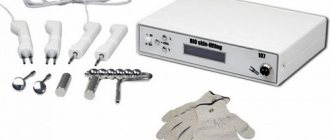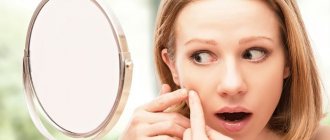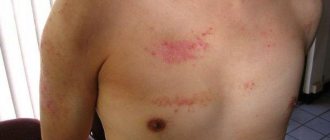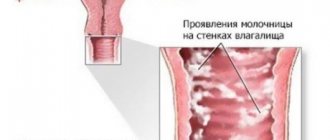Interdigital candidiasis is a common skin pathology caused by a fungal infection of the Candida genus. The inflammatory process occurs between the fingers on the lower and upper extremities. Candidiasis on the hands is caused by the rapid reproduction and growth of opportunistic parasites, which are normally present on the skin and mucous membranes of all healthy people. Mycosis of the hands is most common in countries where a warm and humid climate prevails - favorable conditions for the proliferation of pathogens.
Cutaneous candidiasis: what is it and how is it transmitted?
The disease is diagnosed after taking a skin culture for candidiasis and studying the material under a microscope. In advanced conditions, blood tests are taken to determine the presence of candidiasis in the body. What candidiasis looks like:
Treatment of cutaneous candidiasis varies depending on the degree of neglect and the area of skin damage: for minor manifestations, local therapy with antifungal drugs is used, if the area of tissue damage is large or cannot be treated with ointments and creams, oral medications and injections are also used.
The pathogen can enter the body:
- sexually (from partner to partner as a result of unprotected sexual intercourse);
- household (through household items, bed linen, towels);
- in public bathing (through water);
- through food (stays on poorly washed vegetables and fruits);
- by air;
- as a result of treatment with antibiotics (disturbance of microflora creates favorable conditions for the proliferation of fungus), corticosteroid drugs, immunosuppressants, cytostatics;
- in connection with mental illnesses, cancer, diabetes and tuberculosis;
- pregnancy and menopause are also favorable periods for the growth of fungi;
- as a result of a weakened immune system .
Why does thrush develop on the hands?
Among the factors that provoke candidiasis of the skin of the hands is diabetes mellitus types 1 and 2, accompanied by impaired absorption of sugar in the blood, as a result of which it accumulates at the cellular level, leading to various skin diseases and other complications associated with the functioning of internal organs and systems.
Treatment in this case has two directions. Antifungal drugs are prescribed to help suppress pathogenic microflora. Additionally, drug therapy for the underlying disease is reviewed. If you do not lower your blood sugar to the required level, it will be quite difficult to cope with the pathology.
The main causes of candidiasis on the hands:
- Malfunction of the digestive and gastrointestinal tract. Against the background of improper metabolism, there is a deterioration in the functioning of the entire organism as a whole. In patients with poor digestion, the skin is dry, easily injured, and other infections are often associated;
- Treatment with strong antibiotics disrupts the natural intestinal microflora and weakens the body's natural barrier functions. Often, with antibacterial therapy, a urogenital form of thrush develops;
- Poor nutrition, bad eating habits, deficiency of vitamins, minerals and other beneficial components. If there is a lack of nutrients, the skin dries out, it cracks, and the cracks do not heal for a long period of time;
- Candidiasis as a consequence of an allergic reaction develops in young children. It can be triggered by food, medications, household chemicals and other allergens. If you have a tendency to allergies, you must constantly monitor the cleanliness of your skin and take preventive measures;
- In elderly people who have a history of cancer, candidiasis develops as a concomitant problem;
- Thrush may be associated with a person’s professional activities. For example, those who work with water, chemicals and other similar means. The skin is subject to constant irritation, which leads to an abnormal process.
For information, in patients with tuberculosis, addiction to smoking and alcohol, candidiasis develops with a 99% probability.
Thrush on the hands is similar in clinical manifestations to other skin pathologies, so for an accurate diagnosis it is recommended to visit a dermatologist. During therapy, contact with water, chemicals, etc. must be avoided.
Classification
Fungal infections can be localized in any area of the skin.
Types of candidiasis:
- thrush (candidiasis in the groin) - localized on the mucous membranes of the genital organs;
- candidiasis between fingers and toes ;
- fungal intertrigo - damage to large folds of skin;
- candidal folliculitis - the disease affects the hair follicles in the armpits, on the head, on the face in men;
- bandage candidiasis - manifests itself as a result of increased humidity under a plaster cast or on the back in immobilized patients;
- diaper fungus - canidosis affects the perineal area of infants.
Manifestation of allergies
Acne due to thrush may be the only manifestation, which is associated with an allergic reaction to fungal antigens. At the same time, the body’s sensitivity to the fungal protein increases, which provokes an allergic rash outside the source of damage. Women often experience candidomycids, which appear on the skin of the torso, face, legs and arms during vaginal candidiasis.
Often an allergic reaction occurs when taking glucocorticoid hormonal drugs, antibacterial agents or cytostatics. Allergic acne due to thrush is called levurides or moniliids, which are accompanied by the following symptoms:
- elevated body temperature (no more than 37 degrees);
- general malaise and weakness;
- inflammatory process.
If you conduct a microscopic examination of candidomycids, laboratory technicians will not be able to identify fungi of the genus Candida, which confirms the allergic origin of the rash. But if you carry out skin testing using specific antigens, the result will be positive. To eliminate an allergic rash due to thrush, it is necessary to act directly on the source of infection, then the rash will go away on its own. If there is no therapy, eczema soon develops.
Candidiasis of the ears, eyes, nose, lips (photo)
Candidiasis on the lips (candidiasis, cheilitis) - manifests itself in children and the elderly due to constant humidity (saliva).
The resulting wound under the plaque becomes inflamed and red. Sometimes the swelling from the corner of the lips spreads to the red border. The lips swell, turn red, and their surface becomes dry. The formation of scales, cracks, and crusts is possible. Ocular candidiasis (yeast oculomycosis) is a serious disease that, if not treated appropriately, can lead to significant vision impairment.
It often causes concomitant ailments of the eyeball and eyelids.
Candidiasis of the nose and nasopharynx is an insidious disease, the symptoms of which are similar to acute respiratory infections; because of this, treatment takes a long time without results. Without proper diagnosis, treatment of such a “cold” with antibacterial drugs is useless; antifungal agents are required.
Ear candidiasis (otomycosis) is a dangerous disease that is often misdiagnosed.
May cause hearing loss and sepsis. Accompanied by severe itching and copious fluid flow. The outer ear is also affected - visually the rash in this place looks like weeping eczema.
Symptoms
The first symptom of candidiasis on the skin of the face is the appearance of acne. First they cover the lip area. A purulent fluid forms inside the pimples, and the surrounding skin begins to become inflamed. Gradually, the pustules begin to grow together, forming a single purulent inflammation.
After the pimples burst, erosions form in their place. The edges of erosion are clearly defined. The surface of the spots becomes covered with a white coating and begins to swell. Damage to the skin is accompanied by burning, itching, and pain.
If left untreated, candidiasis is associated with a bacterial infection . A persistent whitish coating appears on the skin, with suppuration with a yellowish tint. The erosions become wet and non-healing ulcers form in their place.
Candidiasis in the mustache, beard and scalp area begins with severe itching. Then severe peeling appears. Dry scales flake off, hair looks stuck together and unkempt.
Nutrition for illness
Diet for mycotic lesions plays a paramount role, because it is important to eliminate internal factors that accelerate the growth of the fungus.
A balanced diet for candidiasis implies:
- exclusion of fatty foods, smoked foods, sweets, starchy foods;
- increasing the amount of vegetables and fruits;
- systematic consumption of fermented milk products.
Treatment methods
A set of measures for the treatment of fungal disease consists of the following points:
- eliminating a favorable environment for the proliferation of fungal pathogens (avoid high humidity and hyperthermia of the skin area, wear loose clothing made of natural fabric, avoid friction);
- dietary food - remove confectionery products and baked goods from the diet; eat more protein foods;
- vitaminization of the body - an increase in the amount of B2, B6, C, PP is required;
- taking topical and oral antifungal medications to treat candidiasis.
To understand how to get rid of candidiasis forever, you need to understand the cause of the disease, only after it is eliminated the body will be able to protect itself from this fungus.
There are many different medications against candidiasis: tablets, gels, ointments, creams, soaps with antifungal ingredients, shampoos. All of them are prescribed depending on the severity of the disease. For the same reason, individual treatment regimens for candidiasis are selected.
Mild forms of candidiasis are treated with external agents based on pimafucin, clotrimazole, sodium tetraborate.
Recurrent and chronic forms of the fungus are treated systemically using 3 groups of anticandidiasis drugs: polyene antibiotics, imidazoles and triazoles.
In some cases, the treatment of candidiasis is supplemented with soda - the inflamed areas are wiped with a solution: a teaspoon of soda for 200 mg of water.
What does pityriasis versicolor (varicolored) look like in humans, and what methods are used to treat it?
The causes of seborrhea, its forms and methods of treatment are described below.
How roundworms affect human organs: https://parazity-gribok.ru/parasites/worms/vliyanie-askaridov-na-organy.html.
Prevention
Preventive measures include monitoring the health status of people at risk (those with pathologies of the immune system, blood diseases, malignant tumors) and who have undergone serious complex treatment (with antibiotics, hormones or after radiation).
If mycocarriage is detected, the patient is prescribed prophylactic medication for 2–4 weeks. Also, correction of nutrition and treatment of dysbiosis should not be left out of sight. For genital candidiasis, therapy is necessary for both partners.
Candidiasis in any of its manifestations has a number of unpleasant symptoms - redness and itching make everyday life uncomfortable. In addition, a sick person can easily infect his family and people in contact with him. That is why you should not delay the treatment of this disease; a timely visit to the doctor will solve the problem as soon as possible.
Another opinion about candidiasis and other fungal infections on video:
Diagnostics
To diagnose pathology, laboratory tests are prescribed:
- immunogram;
- general urine analysis;
- general blood analysis;
- blood test to determine sugar levels.
The exact diagnosis of the pathology is determined on the basis of clinical tests and a bacterial smear from the inflammatory focus. Do not self-medicate or make a diagnosis. Only a specialist can diagnose the disease, prescribe drug therapy and a special diet.
Lomexin about fungus and instructions for its use
